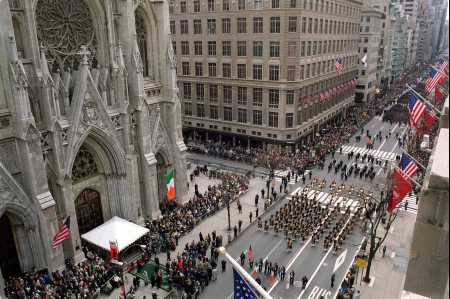The parade has become the largest in the world and has continued strong since 1762.
New York City’s Saint Patrick’s Day Parade is the largest parade in the world. The parade starts every year at 11 a.m. at 44th Street. It marches up Fifth Avenue, past St. Patrick’s Cathedral, ending at 86th Street about five hours later. There are sometimes a quarter million participants in the parade annually including those in the National Guard’s 69th Regime, who lead the parade. The New York St. Patrick’s Day Parade does not include any automobiles or floats. Irish societies, schools, clubs, national societies, bands, police officers, and firefighters march in the parade. About two million spectators line Fifth Avenue every year and the parade is also televised and available by live web stream.
The largest Saint Patrick’s Day Parade thus far has been the 2002 parade which was dedicated to the “Heroes of 9/11”, honoring those who lost their lives during the September 11th attacks. Edward Cardinal Egan was the grand marshal and there were about 300,000 marchers and over three million spectators.
The first Saint Patrick’s Day Parade was held in 1762 and organized by Irish members of the British military who were stationed in the colonies. During the early years of the parade, marchers would meet at their parishes and make their way to the old St. Patrick’s Cathedral where the Archbishop would address the people. The military was responsible for organizing the parade every year until the War of 1812, after which Irish societies took control of the parade duties. The parade route was also changed around this time.
The parade has also been the subject of controversy in recent years. The organizers of the parade have banned Irish gays and lesbians from marching together. Gay rights groups have been fighting to be granted the right to march with their organizations. Among other issues at the parade, public drinking has always been an concern. Public drinking is prohibited and people are often reminded that anyone found consuming alcohol can be arrested and fined, and their alcohol confiscated. School absences on Saint Patrick’s Day in New York City are also an issue, as many Irish-Americans and others miss school to attend the parade.
Each year a grand marshal is chosen to lead to parade. Last year’s grand marshal was New York City’s Police Commissioner, Raymond W. Kelly. Past grand marshals have included political figures, writers, actors. Irish President, Mary McAleese turned down the invitation to be the grand marshal of the 2011 parade. McAleese has is a strong supporter of gay and lesbian groups in Ireland thus she has turned down the invitation because of the parade’s banning of homosexual groups. As a result, Mary Higgins Clark has been named the grand marshal for the parade this year. Clark is a novelist of Irish descent who was born in the Bronx. She has been active in Catholic affairs and has received many honors from various organizations.
The Saint Patrick’s Day Parade also has political significance. Politicians who are currently in office, and those who are running, will make the political decision of whether or not to march in the parade. Former New York City mayors such as Ed Koch, who once said he was Ed O’Koch for the day to honor the Irish, and Rudy Giuliani have marched in the parade and so has his successor, the current Mayor Michael Bloomberg. Those who have opted out of marching include Andrew Cuomo. Hilary Clinton decided to march in 2000’s parade, but not in 2001, and then again in 2002. Since the New York City parade bans gay and lesbian organizations from marching, many politicians choose to march in the Queens parade, which allows them to participate.
Although this year will mark the 250th anniversary of New York’s Saint Patrick’s Day parade, it will not be the biggest and most elaborate the city has seen. New restrictions went into effect as of April 1, 2010, which is requiring parades in New York City to be shorter in order to save money. Parades must now cut their budgets by twenty-five percent and reduce the time to under five house. These budget limitations will save an estimated three million dollars.
The parade is held every year on March 17, except when this day falls on a Sunday, in which it is held on March 16. When the parade kicks off on March 17th, 2011, it will be the 250th consecutive year that the tradition takes place in New York City. Marchers and spectators wear green clothing, hats, and beads as this color symbolizes Irish pride. The Parade is held in honor of the Archdiocese of New York and of Saint Patrick, who is the patron saint of Ireland.
Despite budget cuts, the 250th anniversary of New York City’s Saint Patrick’s Day Parade will surely succeed in honoring and celebrating the Irish heritage.

No comments:
Post a Comment